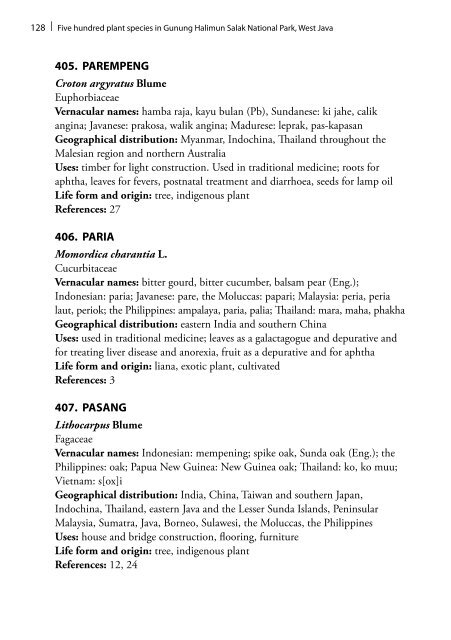Five hundred plant species in gunung Halimun Salak ... - CIFOR
Five hundred plant species in gunung Halimun Salak ... - CIFOR
Five hundred plant species in gunung Halimun Salak ... - CIFOR
You also want an ePaper? Increase the reach of your titles
YUMPU automatically turns print PDFs into web optimized ePapers that Google loves.
128 | <strong>Five</strong> <strong>hundred</strong> <strong>plant</strong> <strong>species</strong> <strong>in</strong> Gunung <strong>Halimun</strong> <strong>Salak</strong> National Park, West Java<br />
405. PAREMPENG<br />
Croton argyratus Blume<br />
Euphorbiaceae<br />
Vernacular names: hamba raja, kayu bulan (Pb), Sundanese: ki jahe, calik<br />
ang<strong>in</strong>a; Javanese: prakosa, walik ang<strong>in</strong>a; Madurese: leprak, pas-kapasan<br />
Geographical distribution: Myanmar, Indoch<strong>in</strong>a, Thailand throughout the<br />
Malesian region and northern Australia<br />
Uses: timber for light construction. Used <strong>in</strong> traditional medic<strong>in</strong>e; roots for<br />
aphtha, leaves for fevers, postnatal treatment and diarrhoea, seeds for lamp oil<br />
Life form and orig<strong>in</strong>: tree, <strong>in</strong>digenous <strong>plant</strong><br />
References: 27<br />
406. PARIA<br />
Momordica charantia L.<br />
Cucurbitaceae<br />
Vernacular names: bitter gourd, bitter cucumber, balsam pear (Eng.);<br />
Indonesian: paria; Javanese: pare, the Moluccas: papari; Malaysia: peria, peria<br />
laut, periok; the Philipp<strong>in</strong>es: ampalaya, paria, palia; Thailand: mara, maha, phakha<br />
Geographical distribution: eastern India and southern Ch<strong>in</strong>a<br />
Uses: used <strong>in</strong> traditional medic<strong>in</strong>e; leaves as a galactagogue and depurative and<br />
for treat<strong>in</strong>g liver disease and anorexia, fruit as a depurative and for aphtha<br />
Life form and orig<strong>in</strong>: liana, exotic <strong>plant</strong>, cultivated<br />
References: 3<br />
407. PASANG<br />
Lithocarpus Blume<br />
Fagaceae<br />
Vernacular names: Indonesian: mempen<strong>in</strong>g; spike oak, Sunda oak (Eng.); the<br />
Philipp<strong>in</strong>es: oak; Papua New Gu<strong>in</strong>ea: New Gu<strong>in</strong>ea oak; Thailand: ko, ko muu;<br />
Vietnam: s[ox]i<br />
Geographical distribution: India, Ch<strong>in</strong>a, Taiwan and southern Japan,<br />
Indoch<strong>in</strong>a, Thailand, eastern Java and the Lesser Sunda Islands, Pen<strong>in</strong>sular<br />
Malaysia, Sumatra, Java, Borneo, Sulawesi, the Moluccas, the Philipp<strong>in</strong>es<br />
Uses: house and bridge construction, floor<strong>in</strong>g, furniture<br />
Life form and orig<strong>in</strong>: tree, <strong>in</strong>digenous <strong>plant</strong><br />
References: 12, 24

















